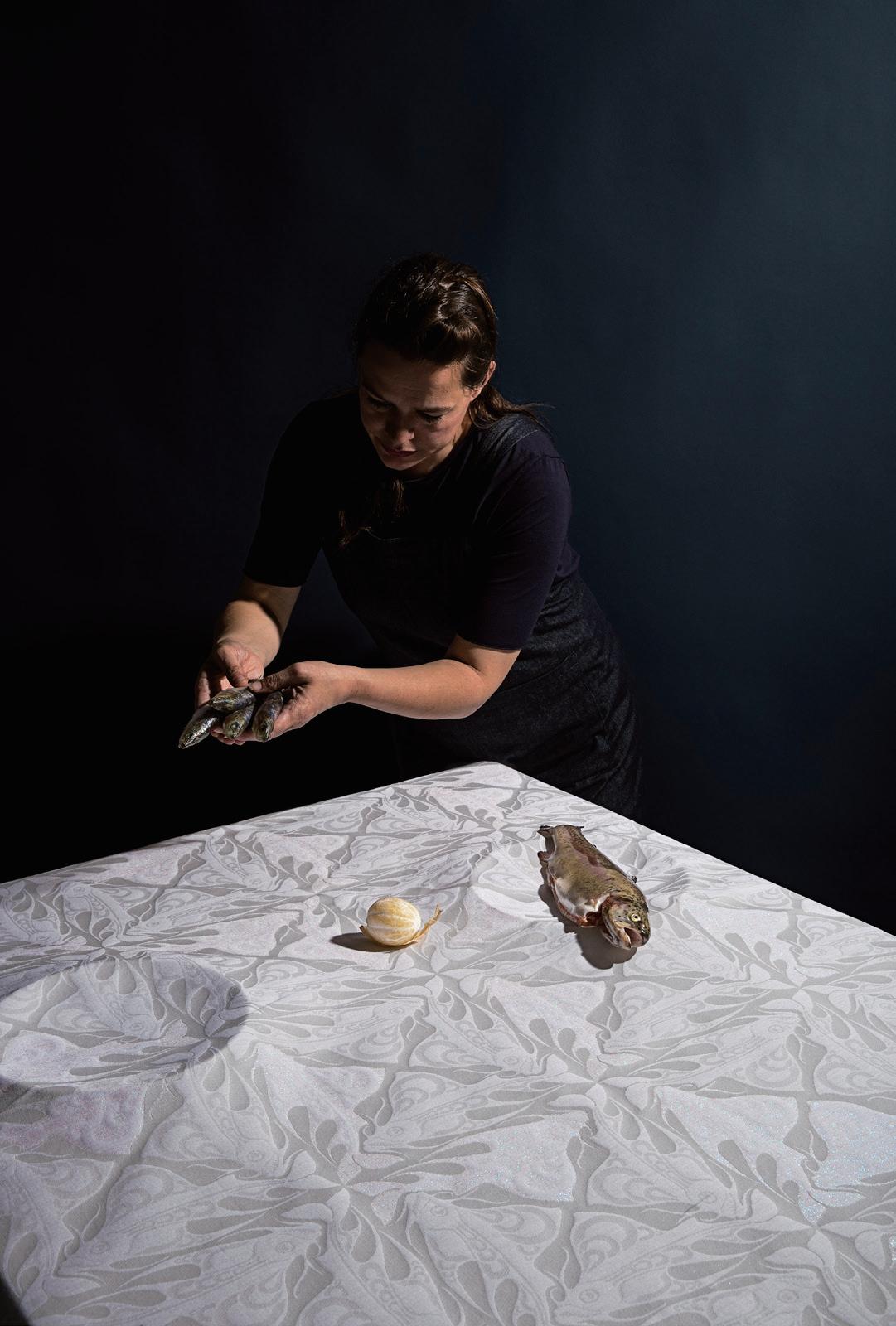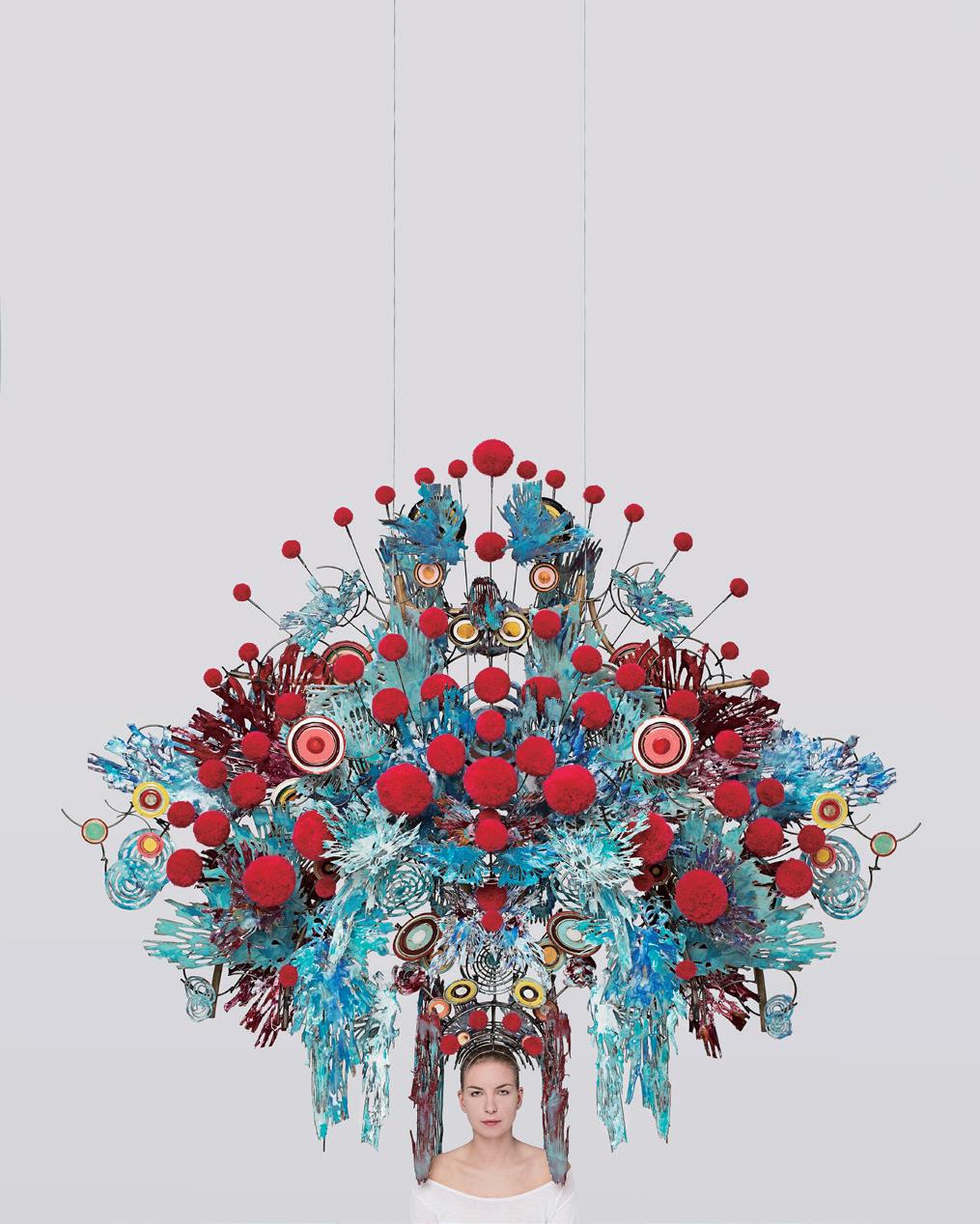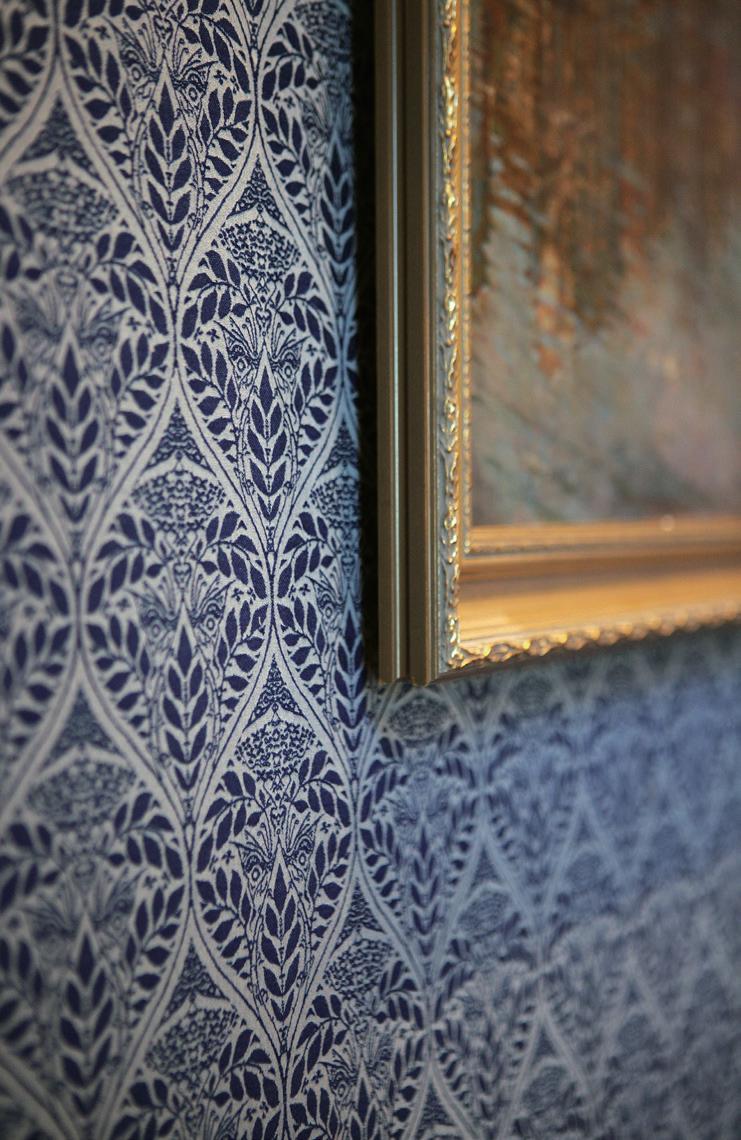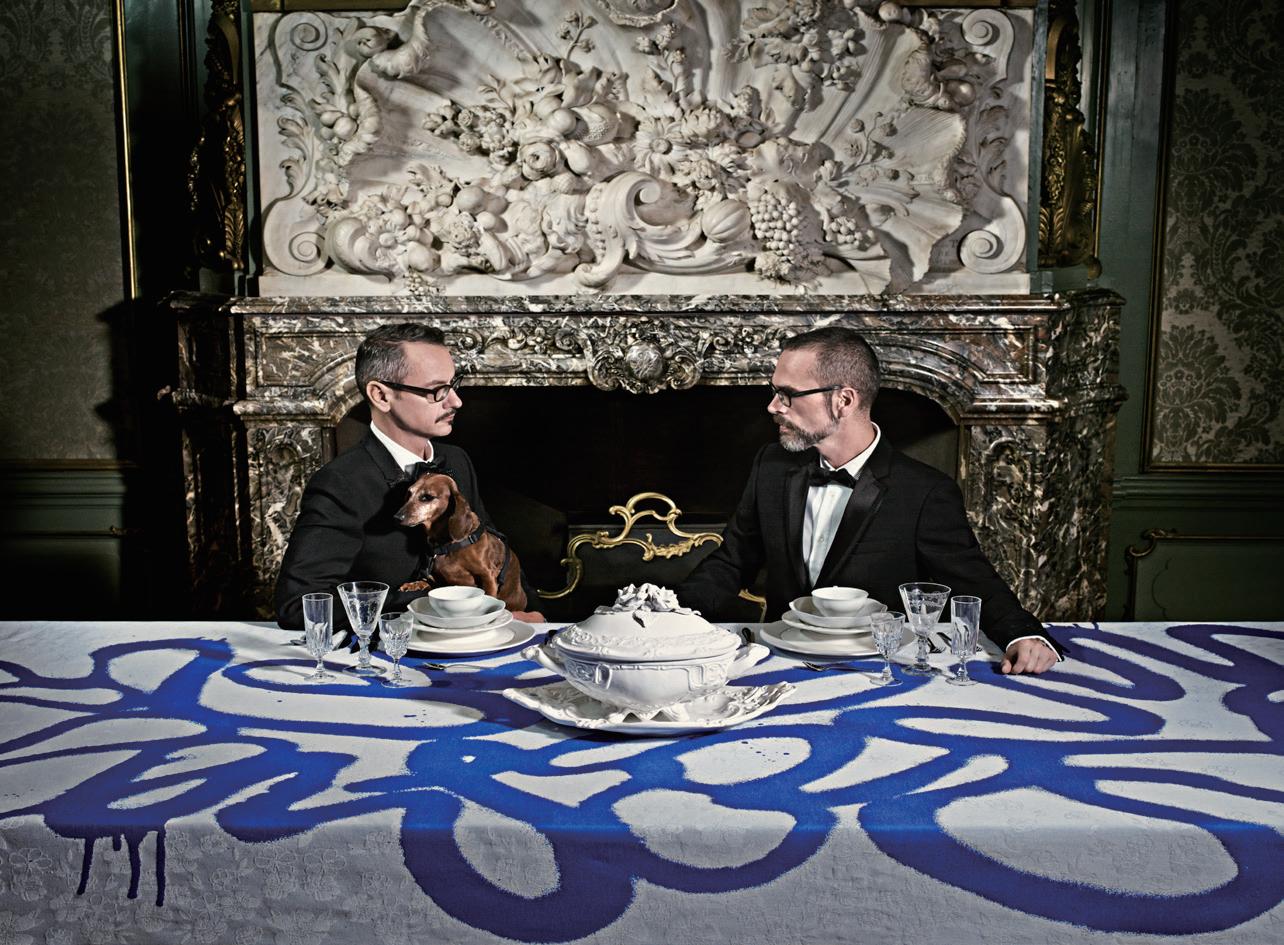
18 minute read
How Industrial Heritage Shaped Our Making Activities
from A Reader TECHSTYLE Series 2.1: Fabpublic! -Talking about Textile, Community and Public Space
by mill6chat
Errol van de Werdt
The TextielMuseum ingredients for a more is the keeper of a classical approach heritage collection. towards establishing This collection is the a museum. That was result of the industrial how the TextielMuseum past of the city of Fig. 1 The TextielMuseum / 2016 started, and was Tilburg. It is located Photo credit: Josefina Eikenaar/TextielMuseum the starting point for in the southwest its transition into a part of the Netherlands, between Antwerp and “working” museum, which is more of a combination Rotterdam. The city has had a long history in of a museum and a workshop. The beating the wool industry, starting in the Middle Ages. heart of the museum is the TextielLab: in part a For hundreds of years wool was the backbone specialised workshop and in part a laboratory for of the local industry. From the 18th century – the manufacturing of woven and knitted textiles. due to mechanisation and industrialisation – the In the near future, the next step will be made to local wool industry grew rapidly, until at its peak transform the museum into a museum of making, in 1881 Tilburg had as many as 145 wool mills. in anticipation of the new industrial revolution: This wool capital of the Netherlands collapsed the Industry of Making 2.0. Our future TextielLab in 1960 and, by 1980, had nearly disappeared. visitors will also be able to customise some On the remnants of hundreds of years of textile products themselves. craftsmanship and industry a museum was established in 1958. Since 1986 the museum has The role of the collection been set in a former 19th century textile factory. In 2008 the museum reopened after a large- The museum collection and its archives are an scale renovation. The combination of a restored important part of our shared cultural capital. The industrial building with modern architecture collection of the TextielMuseum is composed reflects the concept of the institution: creating of several different sources: 200,000 objects, a dialogue between the past and the present of 6,000 images and sound records, 3,000 textile both the local and the wider European textile techniques, a specialised library of 25,000 industries, with an emphasis on the importance of books, a large sample collection, and a material a heritage-based creative industry (Fig. 1). reference collection. Within the museum walls are centuries of accumulated knowledge on crafts, materials, techniques, patterns and recipes. These form the starting points for the present role of this heritage
The next step: a museum of making
Preserved industrial heritage buildings and a collection of objects from past times form the

Fig. 2 TextielLab, knitting department 2013 Photo credit: Tommy de Lange commissioned by TextielMuseum
collection within the described museum concept. They function both as a source of knowledge, as well as an inspiration for artists and designers before starting in the TextielLab. The museum collection is often a forgotten source of information. Curators serve as the guides and translators. By connecting this knowledge with the newest technology, modern yarns, product developers, and the museum technicians, new knowledge can be gained. Scientific institutes, universities, and private enterprises, are always searching for ways to add value. Museums are well suited to be partners in the sharing of knowledge with the public through exhibitions, educational programmes, and other activities. The museum thus becomes part of a network of organisations in which different partners with different knowledge sources and skills cooperate with each other to solve contemporary assignments.
The role of the TextielLab within the museum concept
An important part of our museum concept is the TextielLab, which is the beating heart of our museum. It is a unique knowledge centre that is a highly specialised laboratory for innovative fabrics and applications. Through facilitating designers, artists, fashion designers, and students in their projects with the knowledge and expertise of our product developers and technicians, it becomes possible to explore the endless possibilities of materials and techniques. The TextielLab is an open source laboratory, and therefore, innovation can take centre stage, and can be developed further and faster. We try to create an ideal place for designers and artists, facilitating their projects with all the support they need: technicians, product developers, yarn experts, and access to our collection and information centre. Museum visitors are also given open access to all the activities of the institute. They can look over the shoulders of the designers and learn from their skills, and follow the creative process “live” (Fig. 2).
Reinterpreting heritage collections
The museum, its collection and the activities of the TextielLab, are connected in an integrated way. The reinterpretation of heritage in different ways is a core activity. Before analysing the way this is executed, I will start by looking back in time to define the term “reinterpretation” and put it in a historical context.
Reinterpretation is the act of reformulating something in a new or different way. This can be done in a retrospective or contemporary way (such as with contemporary artists). By doing so, new meanings, indications, or information can be added which can be valuable in a contemporary setting.
In a way, the phenomenon “reinterpretation” is not new. Art historians have been using the Latin terms translatio, imitatio and aemulatio that have been commonly used in both Roman times and the Renaissance era. These terms focus on the extended appreciation of a new work of art, based on, and inspired by its source. The less appreciated, at the time, was translatio [interpretation]: a remake of the source. Imitatio was about the imitation of the style of the predecessor, with the result being a complete new work of art. The highest goal, starting from the Renaissance period was aemulatio in which the artist surpasses his predecessor. So in the Renaissance era, in a way, creating something new inspired by works of art of the


(left) Fig. 3 Pattern drawing by Theodoor Nieuwenhuis from the TextielMuseum collection re-used by ZZDP Architects for new fabric for Koninklijke Industrieele Groote Club in Amsterdam Photo credit: Tommy de Lange commissioned by TextielMuseum
(right) Fig. 4 Panels in the Koninklijke Industrieele Groote Club in Amsterdam / 2015 Photo credit: Cynthia van Dijke
past (aemulatio) was the highest goal to reach. Today, translatio is no longer really accepted as a work of art, not in a cultural, nor in a juridical way, although new technologies, such as 3D printing, are re-engaging this discussion on authenticity.
In essence, it is all about the reinterpretation of the work of predecessors. We are always building upon the shoulders of giants. Museum collections are considered sources of − sometimes forgotten −information and expertise. With this in mind, we will return to the topic of reinterpretation of heritage collections in order to find out in what way this schema can still be useful for museum practice today.
Different forms of reinterpretation in museum practice today
I have started this essay with the statement that the museum collection is considered to be a shared cultural capital and a source of knowledge and expertise. Reinterpretation by artists and designers starts with the studying of heritage objects in the collection, which can be seen as an accumulation of generations of knowledge and expertise. We have to realise that a non-contemporary object is made in the various contexts of time, place, culture, and by a maker influenced by the style or fashion of that time. Such objects are executed with a specific functionality and aimed at a certain public. There are always limitations of technology, material, and cultural approval. By rethinking the way the source object was made, innovation can start. By including the newest technology, modern materials, and a new perspective, a reinterpretation can be realised.
Some cases
As mentioned above, translatio is culturally no longer accepted. On the basis of some cases in the TextielMuseum, executed by the TextielLab, forms of imitatio and aemulatio − the remake and the imitation of the style of a predecessor − will be described and illustrated. These examples show different forms of reinterpretation, executed in a more or less autonomous way, depending on the application.
Textile wall panels inspired by Theodoor Nieuwenhuis
Two original art nouveau designs from the museum collection, textile wall panels by Theodoor Nieuwenhuis (1866-1951), (Figs. 3-4) were the starting point and source of inspiration to develop a new fabric for an old gentlemen’s club in the heart of Amsterdam, as part of an extensive refurbishment by ZZDP architects. The club is now a modern venue for professionals and businessmen to gather. The interior still retains many art nouveau features similar to these textile wall panels. The original patterns from the collection of the TextielMuseum functioned as a source object and inspiration for the designers

Fig. 5 Museum De Lakenhal / Christie van der Haak – Nieuw Leids Laken / 2015 Photo credit: Museum De Lakenhal

Fig. 6 Viktor&Rolf, table cloth Graffiti for the label “by TextielMuseum”. Produced in the TextielLab 2014 / Photo credit: Philip Riches


Fig. 7 Du Hameel print, after Bosch
Fig. 8 Jan Fabre – tapestry De terugkeer van de olifant (The return of the elephant) / 2015 Photo credit: Angelos bvba / Jan Fabre (design), TextielMuseum (producer), Noordbrabants Museum’s-Hertogenbosch (collection), Peter Cox, Eindhoven (photo)
to develop a contemporary look and feel. The idea was not to make an exact copy because there was no clear or exact reference in the building itself.
New patterns on classical “laken”
For centuries, the city of Leiden has been renowned for its high-quality “laken” and woollen fabrics. To honour this impressive textile tradition, the Museum de Lakenhal in Leiden asked five designers to develop new patterns. Kicking off these series was artist Christie van der Haak, who was inspired by the colourful and exotic motifs she discovered in the Leiden collection. Together with the TextielLab and with the support of Woolmark, Van der Haak found creative solutions with different bindings, yarns, and finishing (Fig. 5).
Viktor&Rolf graffiti tags in Delft Blue on damask
Another application has been the development and production of an exclusive range of household textiles designed by top designers as part of our label By TextielMuseum. The goal of the label is to democratise design and make it affordable for everybody. It is executed in co-production with artists, designers and the TextielMuseum. The label always includes further information, such as the story behind the design.
In the case of Viktor&Rolf, the rich museum collection and the craftsmanship of the TextielLab combined powerfully. Top designers design exclusively for the label. More than a century of art and design heritage functioned as the main source of inspiration. Renowned fashion designers Viktor&Rolf created exclusive household textiles in which street culture and traditional textiles converged. Giant graffiti tags in Delft Blue are woven into damask organic cotton tablecloths and tea towels, in order to display dripping paint effects (Fig. 6). With the entire museum collection available for inspiration, the designers can see their vision translated into original products at the TextielLab. The floral motif of the table linen and napkins, as well as the tea towel design’s traditional checked pattern, were inspired by the museum’s rich damask collection. For the designers it was an opportunity to add their signature style to the glamour of the source object, damask, that has now gained a new contemporary expression.
The return of the elephant − Jeroen Bosch
Around 1530 a series of five tapestries – with compositions based on paintings by the famous Dutch artist Jeroen Bosch − were executed in Brussels by local weavers. Only one incomplete series is left today, currently in the collection of the Patrimonio Nacional in Madrid. The missing fifth tapestry is known only by description. An existing contemporary source is a print of a battle elephant by Alaert Du Hamel (1450-1506) (Fig. 7). While organising a retrospective exhibition on the work of Bosch, the Noordbrabants Museum commissioned the Belgian artist Jan Fabre to make a contemporary translation in co-production with the TextielLab. The idea was to “bring back the elephant to the Netherlands”. Fabre created a
tapestry with the design of an elephant (Fig. 8). It has a tower on its back, symbolising power. The elephant is surrounded by references to ancient guild symbols representing economic power. For the artist this is his reference to the 21st century, “Today, not the government, but the businessmen rule the world”. The tapestry is a contemporary and free interpretation of Jeroen Bosch executed with modern technology and yarns. The assignment was not to make a replica. The artist made it in co-creation with a product developer/master weaver from the TextielLab, and Fabre considers himself as “the assistant of the weaver, who translates my ideas to the fabric”.
New table linen inspired by art nouveau. A reinterpretation of Lebeau
The museum commissioned Iris Toonen and Elske van Heeswijk (Studio Prelude) to reinterpret the classic and iconic table linen Visschen [translated as “Fish”] by former decorative artist Chris Lebeau (1878-1945). Lebeau’s work is well known for his high-quality damask, on which he drew strictly stylised designs of nature based on the art nouveau style. The contemporary designers added new colours and contemporary reflective yarns. Some of the fish designs display all the colours of the rainbow when laid out on a table and exposed to different angles of light, which makes them seem to almost “swim”. The designers focused on new bindings and yarns (Fig. 9). In a way, they made a logical next step, a step that Lebeau himself could not have made at the time due to technological limitations. A new contemporary design, yet with a reflection of the past, is the result.
Customisation of objects: Studio Job
A new phenomenon is the use of existing designs as a starting point to customise and add a personal touch to products. In many art disciplines (e.g. in music, through the remixing of songs) this is already a common idea. In a similar way, commercial brands like Adidas, facilitate customers to “recreate” their basic shoes by adding coloured soles or different designs. At the TextielMuseum, a tea towel by the Dutch design duo Studio Job can be customised by visitors. Together with the product developer, they embroider a specific part of the challenging designs, entitled Perished, Insects and Folklore, with, for instance, golden yarn (Fig. 10). The result is a tea towel with a personalised design. In my view, this can be seen as a form of democratisation of the TextielLab. By allowing non-designers to cocreate a new design, we facilitate the ultimate form of visitor participation.
Collection assignments, a contemporary way of collecting
The museum is using the TextielLab to execute collection assignments, as well as also realising projects – autonomous artworks – for artists themselves. Collection assignments were initiated at the end of the 1990s. Artists and designers are given the time and space to experiment with, and to do research on, different textile techniques. They sometimes explicitly ask to consider the museum collection as a source of inspiration to develop new contemporary works. By doing so, a unique contemporary collection can be achieved, with the new works being added to the already existing museum

Fig. 9 Studio Prelude, Visschen (nr. 561) for the label ‘by TextielMuseum’, after Chris Lebeau, produced in the TextielLab / 2016 Photo credit: Joep Vogels commissioned by TextielMuseum
Fig. 10 Studio Job – tea towel Perished for the label ‘by TextielMuseum’, produced in the TextielLab Photo credit: Tommy de Lange commissioned by TextielMuseum


Fig. 11 Heringa & Van Kalsbeek – Armor / 2016 Photo credit: Tommy de Lange commissioned by TextielMuseum
collection. Collecting, in this case, is not done retrospectively, but through the process of co-creation. The new objects will always be exhibited – together with samples and sketches –in one of our exhibitions. These sketches and samples are also collected and documented for the purpose of sharing knowledge with other artists and the public.
An example: an evocative sculpture by Heringa/Van Kalsbeek
Amsterdam based artists Heringa/Van Kalsbeek create evocative sculptures assembled from a variety of found objects. The TextielMuseum asked the artists to develop a large new work for the museum collection. Inspired by their own collection of an assortment of ethnographical artefacts, and a traditional Chinese bridal headpiece in particular, the artists created intricate wing-like shapes of laser-cut canvas. These parts are fixed by a coloured resin and draped over a metal frame to resemble a “drawing in space”. The finished piece was on show at the TextielMuseum exhibition “Fringes of Beauty” in 2017 (Fig. 11).
It is through reinterpretation by artists and designers who are inspired by the museum collection − our shared cultural capital − that a heritage-based legacy lives on for future generations. Innovation can be considered to be a way of rethinking the way we have done things so far. By adding new technology, modern yarns, and the vision of an artist, new cultural heritage is born.
Errol van de Werdt
Director CEO, Textielmuseum, Netherlands
Errol van de Werdt was educated in different cities in the Netherlands-leiden, Amsterdam, Groningen and Zwolle. He received a bachelor degree in Museology from the Reinwardt Academy in leiden and a master degree in Art Histrory and Archeology in Amsterdam. In 2000 Errol became director of collections and research in Utrecht Centraal Museum. Recently he started as general director of the TextielMuseum and TextileLab and is now general director (CEO) of the Mommers Heritage Foundation which includes beside the TextielMuseum and TextielLab, the regional archives, the Local History Museum, and Vincent drawing school. The TextielMuseum includes a research Laboratory and an international Textiles Trainee programme to give talented students from all over the world the opportunity to do research, study and develop textiles prototypes or autonomous works. At the TextielMuseum research, study and exhibitions place much emphasis on crossovers between the different disciplines such as design, art, fashion and architecture.
埃洛・范德維

Fig. 1 紡織博物館外觀 / 2016 圖片版權:Josefina Eikenaar / 紡織博物館
蒂爾堡的紡織博物館收藏著該市的工業遺產,城市位於荷蘭西南部,介乎安特衛普與鹿特丹之間。該市 歷史悠久的羊毛紡織業始於中世紀,幾百年來一直是當地的支柱工業。從十八世紀開始,由於機械化和 工業化的推進,當地羊毛工業迅速發展,至 1881 年蒂爾堡的羊毛工廠達到 145 間。而自 1960 年起,這 個荷蘭的羊毛之都開始走下坡,至 1980 年幾乎所有工廠消失殆盡。1958 年一座博物館在數百年紡織工 藝及生產的歷史餘燼中建立起來,1986 年搬進一座由十九世紀紡織工廠改建的館址。2008 年博物館進 行大型裝修後重新開放,擴建工程結合翻新的工業樓與現代建築,反映出博物館的理念—敘述當地與歐 洲古今的紡織工業,強調創意工業建基文化遺產之重要(Fig.1)。
下一步:製作者博物館
館藏的角色


(左)Fig. 2 紡織博物館收藏的Theodoor Nieuwenhuis新藝術風格布料牆紙手繪圖,啟發 ZZDP 建築師事務所 為阿姆斯特丹紳士俱樂仿造出新牆紙 / 圖片版權:Tommy de Lange,紡織博物館委約
(右)Fig. 3 阿姆斯特丹紳士俱樂部內牆紙 / 2015 / 圖片版權:Cynthia van Dijke
博物館理念中紡織實驗室的角色
重新闡釋歷史藏品
某程度上,「重新闡釋」並不是新鮮事。藝術史 學家一直沿用羅馬時代、文藝復興時期通用的術 語「translatio」、「imitatio」、「aemulatio」, 開闢從靈感源泉欣賞新藝術作品這個新層面。在 當時,最低目標是「translatio」(闡釋):即 再造原物。「Imitatio」是指對前作的模仿,結 果是全新的藝術創作。然而,自文藝復興以來的 最高目標是「aemulatio」,即超越前人,從舊 作品啟發出創新作品。今天,「translatio」不 管從文化或法律意義都不算藝術品。儘管3D打 印等高科技的出現,又引起人們議論藝術真伪的 問題。

Fig. 4 Lakenhal 博物館/ Christie van der Haak《Nieuw Leids Laken》布料作品/ 2015 /圖片版權:Lakenhal 博物館
略。為此我們將「重新闡釋」歷史藏品,找出這方法 現時可行的方向。
現今不同方式的重新闡釋
一些案例
仿TheodoorNieuwenhuis風格的布料牆紙
古典床單的新圖案
數 百 年 間 萊 頓 市 以 其 高 品 質 的 床 單 和 羊 毛 布 料 而 聞 名。Lakenhal 博 物 館 為 向 享 譽 的 紡 織 工 藝 傳 統 致 敬,邀請了五位設計師創作新圖案。Christie van der Haak 率先從萊頓博物館藏品發現了豐富多彩、充滿異 國情調的圖案,在 Woolmark 的支持下,她聯同紡織 實驗室設計出結合不同縫邊、紗線和裝飾的創意作品 (Fig. 4)。
錦緞上的台夫特藍彩—Viktor&Rolf簽字塗鴉

圖片版權:Philip Riches

Fig. 6 Alaert Du Hamel在博斯作品基礎上創作的版畫

Fig. 7 Jan Fabre《De terugkeer van de olifant》(大象的回歸)掛毯 2015 圖片版權:Angelos bvba/Jan Fabre(設計),荷蘭斯海爾托亨博斯 Noordbrabants(收藏),紡織博物館(製作),Peter Cox(攝影)


Fig. 8 Studio Prelude仿 Chris Lebeau 的作品《Visschen (nr. 561)》(魚)/ 紡織博物館品牌產品、紡織實驗室製作 / 2016 圖片版權:Joep Vogels,紡織博物館委約
Fig. 9 Studio Job《Perished》(死亡)茶巾 / 紡織博物館品牌產品、紡織實驗室製作/ 2017 圖片版權:Tommy de Lange,紡織博物館委約
大象的回歸—Jeroen Bosch
1530年左右,取材荷蘭著名藝術家耶羅恩•博斯 (Jeroen Bosch)畫作的五幅掛毯由布魯塞爾的紡織 工人製成。現今只有馬德里 Patrimonio Nacional 收 藏了不完整的一套,缺失的第五幅掛毯只留下有限的 文字紀錄。Alaert Du Hamel(1450-1506)版畫中 戰鬥的大象形象,是當時保留下來的參考圖(Fig. 6)。 Noordbrabants 博物館在舉行博斯的大型回顧展時, 曾委約比利時藝術家 Jan Fabre 與紡織實驗室一起製 作「大象的回歸」現代版本,目的是「把大象帶回荷 蘭」。他因此創作一幅掛毯,以大象為主題(Fig. 7), 它背上有一座象徵權力的寶塔,四周則佈滿象徵經濟 力量的古代行業公會符號。對藝術家而言,畫面意指 二十一世紀:「今天,統治世界的不是政府而是商人」。 這幅掛毯不是一件複製品,而是藝術家聯同紡織實驗 室的產品開發人員/編織師,利用現代科技和紗線, 以當代自由的角度去詮釋博斯的作品;他更自認為「紡 織工人的助手,他們將自己的概念轉成織品」。
新藝術風格影響的新桌布, 重新闡釋 Lebeau 作品
博物館委約Iris Toonen、Elske van Heeswijk(Studio Prelude),重新闡釋裝飾藝術家 Chris Lebeau (1878-1945)的標誌性經典桌布 Visschen(魚)。 Lebeau 以其高品質的錦緞而聞名,他在新藝術運動 風格的基礎上,發展出以自然為題的風格化繪圖。現 代設計師們在舊作基礎上採用全新色彩及反光紗線, 部份魚紋展現出彩虹七色,從桌布不同的角度觀賞, 它們會發出不同的顏色,看似在桌上游泳。設計師專 注於新的縫邊和紗線技術(Fig. 8),某程度上邁出 Lebeau 因當時技術限制而無法跨出的一步。這體現了 當代設計建基於反思歷史的成果。
個人化產品:Studio Job
當代的新潮流,是利用現有的設計為起點,製作具有 個人色彩的作品。這手法廣泛存在於藝術圈子,例如 音樂界的重新混音,是很普遍的現象。同樣地,商 業品牌 Adidas 邀請顧客「自創」基本鞋款,各自為 鞋子加上顏色鞋底或不同設計。紡織博物館中荷蘭設 計工作室 Studio Job創作的茶巾,也是觀眾自製的 產品。觀眾與產品發展人員合作挑戰難度高的設計 《Perished, Insects and Folklore》,例如用金線繡 出一部份(Fig. 9),結果是很個人化的茶巾。我認 為邀請非設計師共同創作,可看作實驗室走大眾化的 路線,使觀眾能獲得極致的參與體驗。
當代收藏方式:委約藏品

Fig. 10 Heringa、Van Kalsbeek 《Armor》(盔甲)/ 2016 圖片版權:Tommy de Lange,紡織博物館委約
一個例子:Heringa / Van Kalsbeek 的啟發性 雕塑
阿姆斯特丹藝術家 Heringa / Van Kalsbeek 善於利用各種文物創作啟發人心的雕塑 (Fig. 10)。紡織博物館曾委約他們製作大型全 新作品,藝術家參考館藏的民族工藝品,特別是 一件中國新娘傳統頭飾,創作出激光切割精細的 帆布翼片,再將這些組件用有色樹脂固定於金屬 框架,像一件「空間繪畫」作品。作品曾於2017 年紡織博物館展覽「Fringes of Beauty」展出。
生。
埃洛.范德維 荷蘭紡織博物館館長
埃洛.范德維曾在荷蘭萊頓、阿姆斯特丹、格羅 寧根、茲沃勒接受教育。他在萊頓 Reinwardt Academy 完成博物館學學士課程;在阿姆斯特 丹獲得藝術史及考古學碩士學位。在2000年成 為 Utrecht Centraal Museum 的館藏及研究部總 監。近年曾為荷蘭紡織博物館、荷蘭紡織實驗室的 總監,現任 Mommers Heritage Foundation 總 監,轄下除了荷蘭紡織博物館、荷蘭紡織實驗室, 還有 The Regional Archives、The Local History Museum、 Vincent drawing school。荷蘭紡織博 物館的研究中心,並開辦國際紡織培訓計劃,讓各 地有才能的學生去研究、學習、開發紡織品原型或 創新作品。荷蘭紡織博物館的研究、學習及展覽, 強調跨界別如設計、藝術、時裝與建築之間的交流。










